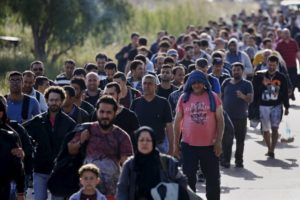Europe’s migration strategy under fire
The European Council this week released a communique highlighting its achievements and claiming it had “regained control of illegal migration flows”.
But data from Europe’s statistics body Eurostat and a report by the UK-based development and humanitarian think tank the Overseas Development Institute (ODI) tell a different story.
While sea arrivals dropped to about 358,000 so far this year, compared to just over one million in 2015, there were 950,000 new asylum seeker claims in EU member states, between January and September.
 In September, a report by ODI predicted the cost of deterring migrants from using well-known sea routes to Europe would be a steep increase in the number of migrants using other little know covert routes.
In September, a report by ODI predicted the cost of deterring migrants from using well-known sea routes to Europe would be a steep increase in the number of migrants using other little know covert routes.
The ODI report estimated that just under half a million people will have used covert routes to reach Europe by the end of 2016.
It also said 2016 will be the deadliest on record for those who have attempted to cross the Mediterranean with almost 5,000 deaths.
One in 47 people who boarded smugglers’ boats in Libya did not survive the journey to Italy.
The ODI report says that Europe’s restrictive policies have not deterred migrants and refugees, but merely forced them to use different and often more dangerous routes.
Meanwhile, other fractures are appearing in the European Union’s approach to solving its migration crisis.
The Turkish Government has reopened conflict with the European Union over refugees, accusing the bloc of ignoring his country’s contribution to the crisis.
Turkey agreed to a deal with the European Union last year to prevent asylum seekers from traveling from the Turkish coast to Greek islands.
The European Union promised in return to pay billions of euros for border controls and give Turkish citizens the prospect of visa-free European Union travel.
But the two sides have clashed of late over the fate of negotiations for Turkey to enter the European Union.
In the months since a coup attempt in July failed to topple Turkish President Recep Erdogan, the conservative Muslim leader has moved to crack down on perceived military and civilian government workers loyal to the coup’s alleged leader Fetullah Gulen.
Meanwhile Germany, which just three years ago introduced an ‘open door’ policy welcoming refugees and asylum seekers, has begun deporting people it deems to be ‘failed asylum seekers’.
A group of 34 Afghan asylum seekers arrived in Kabul last week after being deported from Germany, the first such batch to be sent back after their applications were rejected.
The Afghans, all men, arrived on a chartered flight from Frankfurt, following a disputed Afghan-EU deal earlier this year aimed at curbing the influx of migrants.
Another group of 50 Afghan asylum seekers are set to be deported from Germany by early January.
About 10,000 Afghans have already returned from Europe this year, even though the security situation in Afghanistan worsens amid an escalating Taliban insurgency.
Meanwhile Sweden, which has long prided itself on being a haven for people fleeing persecution, has also begun deportations, disregarding protests by human rights activists.
A new Swedish immigration law gives the police authority to inspect homes of suspected illegal immigrants and to seize their identification documents for deportation purposes.
There have also been cases where Kurdish immigrants who had initially identified themselves as Iraqi Kurds had found themselves on the brink of being deported to Afghanistan.
Meanwhile, the ODI report says the EU’s response to the migration crisis, which has seen €17 billion ($A24 billion) spent on deterring refugees, has only been partially effective.
“The European response to the current migration ‘crisis’ has been swift…through deterring refugees and migrants through tighter border controls and bilateral agreements, such as the EU-Turkey deal,” the report says.
“These measures have been effective in reducing flows – as few as 330,000 refugees and migrants are likely to arrive in Europe this year via the Mediterranean through ‘overt’ routes.
“However, Europe will still see 890,000 asylum applications in 2016. This discrepancy between overt arrivals and asylum applications shows that there are many people whose journeys to Europe we know little about. Border controls have, in many cases, simply rerouted refugees and migrants towards alternative, ‘covert’ routes,” the report says.
It says Europe needs a new approach and makes several key recommendations towards pragmatic and effective management of the crisis, including: European governments facilitating and increasing legal pathways so that they can monitor and more effectively manage flows of refugees and migrants; a new global alliance of migration and displacement data; and, a commitment to more transparency on deterrence costs, as well as the significant reception and procedural costs in both national and EU budgets.
The report also recommends the forging of “new international and regional coalitions built around common interests and objectives that aim to ensure safe, controlled and well-managed migration”.
Laurie Nowell
AMES Australia Senior Journalist












